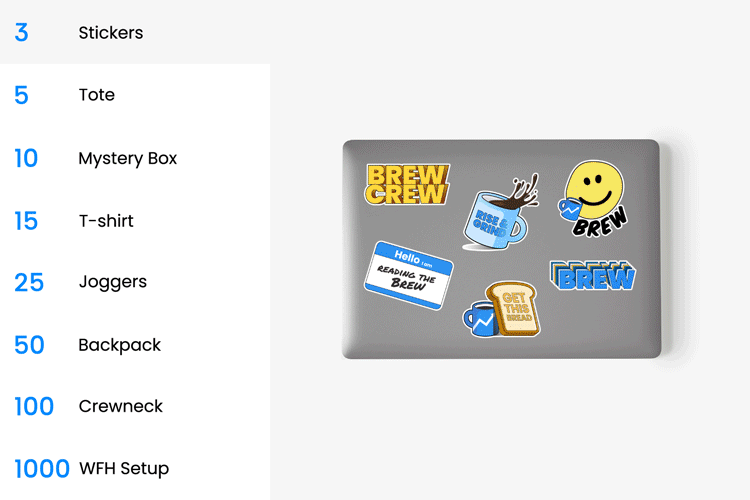Happy Thursday. Is everyone getting ready for burrito season? No, we’re not talking about these cold, dark winter months most people spend curled up in a burrito of blankets—we’re talking about Chipotle’s busy season, which runs from March to May. The fast-casual chain, which is aiming to hire 19,000 employees, is offering new benefits designed to attract Gen Z applicants and support its existing Gen Z employees.
In today’s edition:
—Jasmine Sheena, Alyssa Meyers, Andrew Adam Newman
|
|
Screenshots via @faith_enokian/Instagram, @passingthewater/TikTok
If you’re a TikTok girlie, you’ve probably seen videos that feature Halara clothing. If you’re also a marketer, you may be wondering: How did the brand start showing up everywhere?
It all started, as it often does, with organic content.
One of the earliest viral posts featuring the DTC athleisure brand came in March 2021 from influencer couple Meg and Jack, where Meg surprised Jack while wearing a Halara dress. The post has been viewed nearly 2 million times, and the brand, which began posting on TikTok that same month, took notice, Gabby Hirata, Halara’s global brand president, said.
Halara, which was founded in 2020 by Joyce Zhang, often places paid advertising behind posts like these, which Hirata said has been integral to the brand’s virality. In the past two months, as videos of Halara’s wide-leg and three-button work pants have spread like wildfire on TikTok and Instagram, more than half a million of those two styles were sold on the brand’s website and through TikTok Shop. Halara has also employed affiliate marketing as a way to encourage influencers and ambassadors to spread the word about the brand.
- User-generated content that highlights the brand’s clothing and is “rooted in the personal experience, very authentic, showing insecurity and talking very candidly...performs really, really well,” Hitara told Marketing Brew.
Continue reading here.—JS
|
|
|
Join us in New York for our half-day event focused on the endless possibilities AI offers. Industry leaders from Microsoft, Plus Company, GoCharlie.AI, and many more will share how they use AI in their day-to-day operations.
Grab your ticket now before they’re gone!
|
|
Ethan Miller/Getty Images
In many ways, 2023 was a test-and-learn year for generative AI in marketing. But, much like Channing Tatum taught us in the early-aughts dance franchise, it’s now time to step up.
Creators already seem ahead of the AI curve, and some agency-side advertisers also got an early start navigating the emerging tech, especially considering that clients might turn to their agencies to learn about AI applications.
But brands still tend to be in the education stage, Mary Ann Belliveau, VP of large customer sales at Reddit, said onstage at CES, where AI was a predictably prevalent topic of discussion. However, some brand marketers who spoke at the conference said they have started to dive deeper into AI.
Here are a few of the ways they said they’re taking advantage of the tech.
Creative changes: There have, of course, been concerns circulating around AI, which could be why some marketers haven’t immediately embraced it. David Cohen, CEO of the IAB, said he’s heard his fair share of worries from the industry, but that during his first day at CES, he noticed “much more conversation around the opportunity,” including for assisting with the creative process.
- “It’s not going to replace jobs,” SVP and CMO of Qualcomm, Don McGuire, said. “It’s going to replace tasks.”
Continue reading here.—AM
|
|
NRF/Stratacache
For generations, it was clear who held the cards when it came to the relationship between big retailers and consumer brands. It was big retailers, naturally, who brands pitched, charmed, and cajoled in the hope that they would carry their products on their hallowed shelves and websites.
But that’s not always the case anymore, at least not when it comes to a retail media network (RMN), where retailers who’ve taken a page from media companies pitch brands—often the very brands they carry—to pay them to advertise their products on their apps, websites, and in their stores.
Quentin George, a partner at McKinsey & Company, was recently consulting with the CEO of a retail company building its RMN. The executive was trying to get his arms around how the dynamic was changing now that his company was trying to sell ads to its vendors.
“‘Wait a minute,’” George recalled the executive saying. “‘Does that mean that if I go to lunch with the vendor that I have to pick up the check?’”
“That’s how it’s going to go now,” George recalled responding. “They are becoming the customer.”
George spoke from the stage at the National Retail Federation’s recent convention, at an all-day program with multiple panels focusing exclusively on RMNs. The event, held at the Javits Center in New York the day before other programming began, was organized by NRF and Stratacache, a retail technology solutions company focusing on RMNs. It required a separate registration fee and drew more than 400 attendees.
George and others who shared their perspectives from the stage had opinions about much more than who should pick up the tab. They spoke about the phenomenal growth of retail media, how to best fashion a retail-media campaign, and how major retailers who haven’t yet thrown their hats in are leaving money on the table.
Read more on Retail Brew.—AAN
|
|
TOGETHER WITH INTUIT MAILCHIMP
|
|
Morning Brew
There are a lot of bad marketing tips out there. These aren’t those.
NewZ: A look at Gen Z’s media habits, like where they get their news and what topics they’re most interested in.
Lock and keywords: Why keywords on Google and other search engines still matter for brands.
SE-no: That being said, some argue that SEO could be making Google worse.
|
|
ADVERTISE
//
CAREERS
//
SHOP
//
FAQ
Update your email preferences or unsubscribe
here.
View our privacy policy
here.
Copyright ©
2024
Morning Brew. All rights reserved.
22 W 19th St, 4th Floor, New York, NY 10011
|
|








